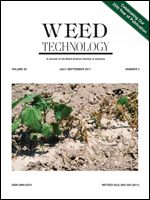Methyl bromide has been widely used as a broad-spectrum fumigant for weed control in polyethylene-mulched bell pepper. However, because of environmental hazards, the phase-out of methyl bromide requires development of alternative weed management strategies. Brassicaceae plants produce glucosinolates which are hydrolyzed to toxic isothiocyanates following tissue decomposition, and therefore can be used as a cultural strategy. Field experiments were conducted in 2007 and 2009 to study the influence of soil amendment (‘Seventop’ turnip cover crop vs. fallow) and the effect of initially planted yellow nutsedge tuber density (0, 50, and 100 tubers m−2) on the interference of yellow nutsedge in raised-bed polyethylene-mulched bell pepper. Total glucosinolate production by the turnip cover crop was 12,635 and 22,845 µmol m−2 in 2007 and 2009, respectively, and was mainly contributed by shoots. In general, soil amendment with the turnip cover crop was neither effective in reducing yellow nutsedge growth and tuber production nor in improving bell pepper growth and yield compared to fallow plots at any initial tuber density. Averaged over cover crops, increasing initial tuber density from 50 to 100 tubers m−2 increased yellow nutsedge shoot density, shoot dry weight, and tuber production ≥ 1.4 times. However, increased tuber density had minimal impact on yellow nutsedge height and canopy width. Compared to weed-free plots, interference of yellow nutsedge reduced bell pepper dry weight and marketable yield ≥ 42 and ≥ 47%, respectively. However, bell pepper dry weight and yield reduction from 50 and 100 tubers m−2 were not different. Light was the major resource for which yellow nutsedge competed with bell pepper. Yellow nutsedge shoots grown from initially planted 50 and 100 tubers m−2 caused up to 48 and 67% light interception in bell pepper, respectively. It is concluded that yellow nutsedge interference from initial densities of 50 and 100 tubers m−2 are equally effective in reducing bell pepper yield and that soil biofumigation with turnip is not a viable management option for yellow nutsedge at these densities.
Nomenclature: Yellow nutsedge, Cyperus esculentus L. CYPES; bell pepper, Capsicum annuum L. ‘Heritage’; turnip, Brassica rapa L. ‘Seventop’.






